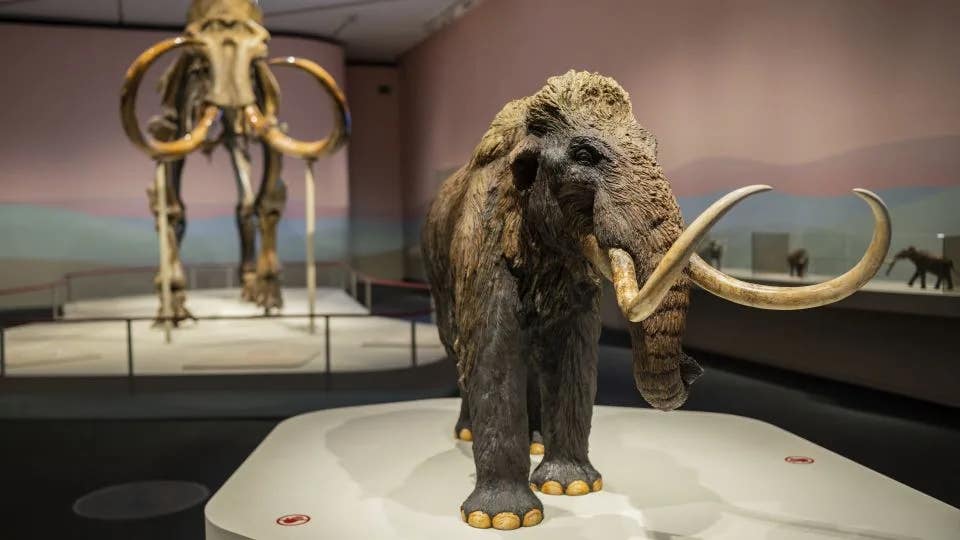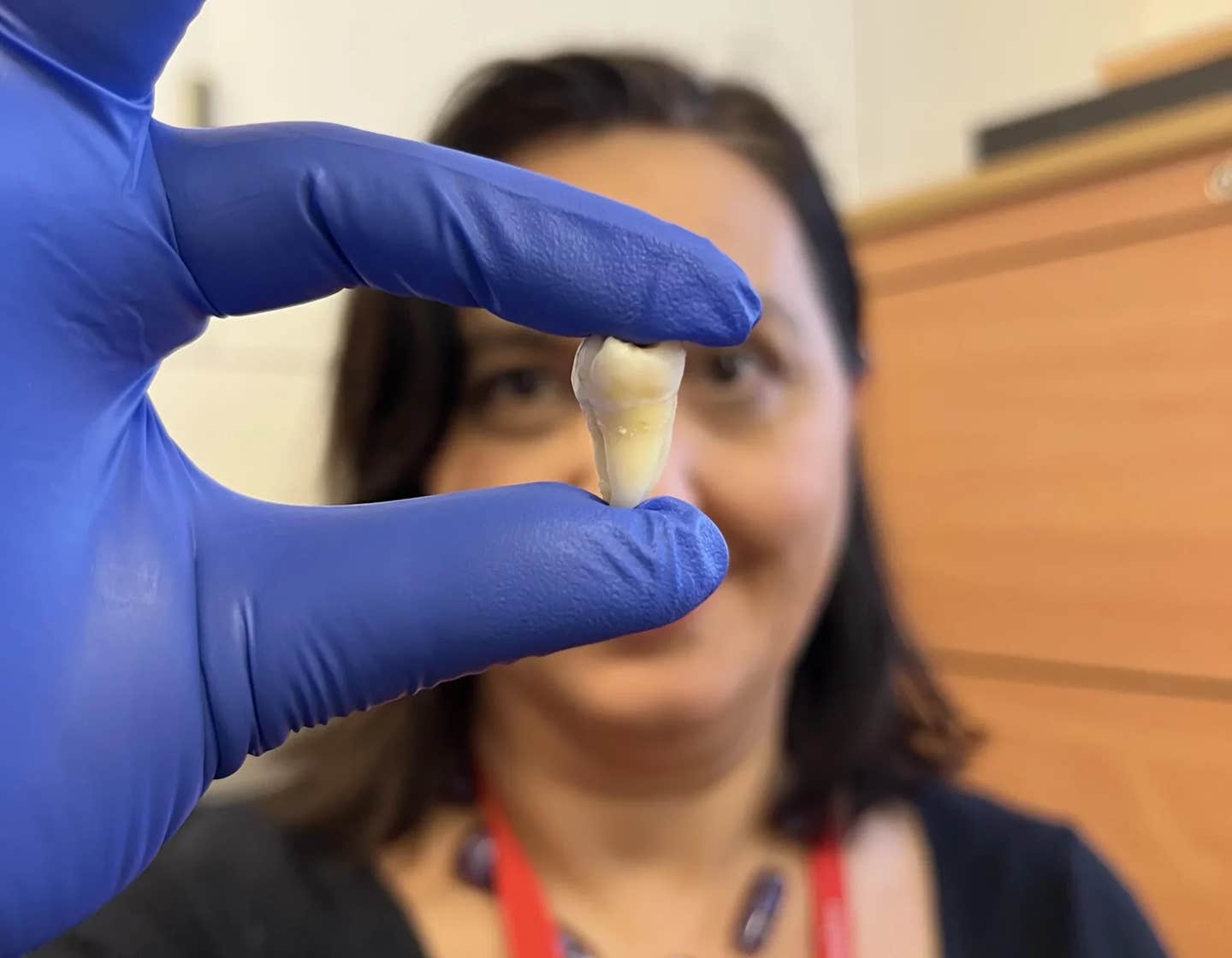Scientists use elephant DNA to bring back the woolly mammoth
Scientists reprogram elephant cells into an embryonic-like state, a big step toward reviving traits of the extinct woolly mammoth.

The fossil of a woolly mammoth (left background) and small replica (right) are shown on display at the CaixaForum in Zaragoza, Spain. (CREDIT: Nano Calvo/VWPCS/AP)
Scientists have made a leap in genetic engineering by pushing elephant cells into an embryonic-like state. This marks a major step toward recreating traits of the extinct woolly mammoth, offering new hope for biodiversity and climate science.
Colossal’s Bold Vision
The team behind this work, Colossal Biosciences, sees it as a path toward tackling big challenges—preserving endangered animals, restoring ecosystems, and refining genetic tools. While bringing back the mammoth is still far off, the science has taken a bold step forward.
The roots of this breakthrough go back nearly two decades. Back then, researchers turned mouse skin cells into versatile stem cells called induced pluripotent stem (iPS) cells. These special cells can grow into almost any tissue, making them key players in gene editing.
Since that first success, scientists have created iPS cells in several species, including drill monkeys and the northern white rhino. But elephants resisted the same methods, posing one of the field’s toughest puzzles.
Harvard Medical School geneticist Dr. George Church, who co-founded Colossal, didn’t sugarcoat the difficulty. “I think we’re certainly in the running for the world-record hardest iPS-cell establishment,” he said. The process took persistence and fresh thinking.
Dr. Eriona Hysolli, who leads biological sciences at Colossal, explained that standard protocols failed at first. Her team had to tweak a chemical recipe used on mice and humans, carefully altering the gene TP53 to get results. That effort finally paid off.
They succeeded in creating four lines of elephant iPS cells. These resemble embryonic stem cells and could be used to engineer mammoth-like features—such as thick fur, fatty tissue, and cold resistance.
For Dr. Church, the dream is to use these iPS cells to grow tissues like hair and blood in the lab. That would let scientists test changes safely and gradually before trying to produce cold-adapted elephants—bringing one step closer a vision once thought impossible.
Related Stories
Melting Arctic Permafrost
But this isn’t just about ancient animals. Melting permafrost in the Arctic—where woolly mammoths once roamed—is a modern threat. As that frozen ground thaws, it risks unleashing huge stores of carbon, with temperatures rising there four times faster than elsewhere.
Microbes frozen for millennia reawaken, breaking down trapped plant and animal matter, releasing both carbon dioxide and methane. If just 2% of Arctic permafrost thaws, up to 28 billion tons of CO2 could enter the atmosphere.
Over 1.6 billion metric tons of carbon are currently trapped in Arctic permafrost, a figure twice as large as the carbon in Earth’s atmosphere today. Beyond carbon, the ice holds heavy metals, pollutants, and remnants of fossil fuel combustion—toxins with the potential to fundamentally alter life as we know it. Preserving permafrost is critical for humanity’s survival.
The woolly mammoth once played a vital role in maintaining permafrost. These megafauna flattened small trees, exposing grasses that reflected sunlight and stabilized the soil. Without them, invasive shrubs have accelerated permafrost thawing.
By reintroducing mammoth-like elephants to the Arctic, scientists hope to restore this lost balance. Dr. Church emphasizes that the ultimate goal is to “increase habitat resilience to climate change and environmental upheaval.”
Reproductive Biology
To achieve this, Colossal’s team is exploring groundbreaking methods of reproductive biology. One approach involves transforming gene-edited iPS cells into sperm and egg cells to create embryos—a technique successfully demonstrated in mice.
Another strategy focuses on synthetic embryos generated directly from iPS cells. Artificial wombs, an area of rapid innovation, could replace the need for surrogate mothers. Such technologies would avoid disrupting endangered elephant populations and scale up efforts to restore Arctic ecosystems.
Dr. Jeanne Loring, a stem cell biologist who pioneered iPS cells in endangered species, believes this achievement will inspire others working on reprogramming cells from difficult organisms. Dr. Sebastian Diecke, another expert in stem cell biology, highlighted the need for further studies to ensure these iPS cells remain stable and can differentiate into necessary tissues.
Meanwhile, Dr. Vincent Lynch, an evolutionary geneticist, has struggled to replicate similar results with elephant cells. Lynch’s work focuses on understanding elephants’ natural cancer resistance, a trait that remains a mystery. Now, he plans to explore Colossal’s methods for creating iPS cells.
The insights gained could not only advance de-extinction but also help uncover why elephants rarely develop cancer, a breakthrough that could benefit human medicine.
The science is clear: Asian elephants share 99.6% of their DNA with woolly mammoths. While the 0.4% difference might seem small, it’s an enormous challenge to bridge. Modern gene-editing tools like CRISPR have made this task more achievable than ever. Dr. Church and Colossal aim to close this genetic gap, using iPS cells and CRISPR to build traits that make mammoth-like elephants possible.
The Five Core Goals
The team’s efforts focus on five core goals: restoring Arctic habitats, developing tools to protect modern elephants, understanding cold adaptation genetics, advancing genome editing, and proving that extinct megafauna can be brought back. Success in these areas could help combat climate change while preventing elephants’ extinction.
Evolution operates on timescales spanning millennia. The genetic changes that made woolly mammoths uniquely suited for the Arctic didn’t happen overnight. Yet the science now exists to recreate those adaptations far more quickly. As the planet warms and permafrost melts, time is running out.
While challenges remain, this breakthrough in reprogramming elephant cells brings humanity one step closer to addressing the Arctic’s instability. Reviving mammoth traits in elephants might sound like science fiction, but the benefits for Earth are real. The question isn’t whether it can be done, but how soon the science will advance enough to make it a reality.
Dr. Lynch sums it up well, expressing cautious optimism: “It’s a distant prospect, but with enough time and resources, it’s possible.” For now, Colossal’s success is a reminder that solving our planet’s most pressing challenges often requires thinking big—and sometimes, looking to the past for answers.
Resurrecting The Wooly Mammoth in Russia
Efforts to revive the woolly mammoth—an Ice Age giant that disappeared around 4,000 years ago—have made steady progress, driven largely by advances in genetic engineering and ancient DNA research.
Russian scientists at the North-Eastern Federal University in Yakutsk have played a major role in recovering some of the best-preserved mammoth remains from Siberian permafrost. These specimens include intact soft tissue and hair, providing valuable sources of ancient DNA for sequencing.
Unearthed just last year near the Yana River basin, the remarkably well-preserved calf—nicknamed Yana—offers scientists a rare window into the distant past and raises new questions about what other ancient secrets might emerge as climate change continues to thaw the Arctic permafrost.
Although DNA degrades over time, the combination of mammoth and Asian elephant genomes has allowed researchers to reconstruct high-coverage genome maps and identify specific adaptations related to life in extreme cold.
Creating a viable hybrid embryo that expresses these traits involves more than gene splicing. The genes must function correctly, and the organism must develop in a healthy, sustainable way. While some research is exploring the use of artificial wombs, growing large mammals like elephants still presents major ethical and technological barriers.
Going Beyond The Lab
Beyond the lab, some scientists from England and Russia envision environmental benefits to reviving mammoth-like animals. The idea is that reintroducing cold-adapted megafauna to the tundra could help restore Pleistocene-era grasslands and slow climate change by compacting snow and reducing permafrost thaw.
This concept is being tested at Pleistocene Park in Siberia, where researchers are observing how large herbivores such as musk oxen, bison, and horses influence the Arctic landscape.
Although no mammoth-elephant hybrid has yet been born, foundational milestones such as genome editing, cellular viability, and ancient DNA analysis have already been reached.
Note: Materials provided above by The Brighter Side of News. Content may be edited for style and length.
Like these kind of feel good stories? Get The Brighter Side of News' newsletter.
Joseph Shavit
Head Science News Writer | Communicating Innovation & Discovery
Based in Los Angeles, Joseph Shavit is an accomplished science journalist, head science news writer and co-founder at The Brighter Side of News, where he translates cutting-edge discoveries into compelling stories for a broad audience. With a strong background spanning science, business, product management, media leadership, and entrepreneurship, Joseph brings a unique perspective to science communication. His expertise allows him to uncover the intersection of technological advancements and market potential, shedding light on how groundbreaking research evolves into transformative products and industries.



